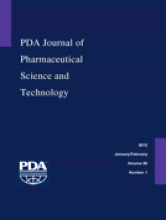Abstract
TECHNICAL ABSTRACT: The purpose of this work was to investigate a potential mechanism for the inhibition of tungsten-mediated monoclonal antibody (mAb) biophysical modifications and sub-visible particle formation. A 1 mg/mL mAb formulated in 150 mM NaCl, 20 mM histidine, pH 6.0, was incubated with 1, 37, and 100 ppm of tungsten polyanions in the form of sodium tungstate both in the presence and absence of the anionic surfactant and chelating agent diethylene triamine pentaacetic acid (DTPA) or the cationic surfactant cetyl trimethyl ammonium bromide (CTAB) for 24 h at 25 °C. Assays including pH, UV-Vis spectroscopy, size exclusion chromatography, intrinsic tryptophan/tyrosine fluorescence, and micro-flow imaging were performed to assess the impact on short-term mAb stability and aggregation. We conclude that the use of micromolar concentrations of the formulation excipient and cationic surfactant CTAB equivalent to the anticipated tungsten concentration in solution effectively inhibits loss of protein concentration, fragmentation, changes in intrinsic fluorescence intensity, and the formation of sub-visible particles.
LAY ABSTRACT: The purpose of this work was to investigate a potential mechanism for the inhibition of tungsten-mediated monoclonal antibody (mAb) biophysical modifications and sub-visible particle formation. A mAb formulation was incubated with tungsten polyanions in the presence and absence of the anionic surfactant and chelating agent diethylene triamine pentaacetic acid (DTPA) or the cationic surfactant cetyl trimethyl ammonium bromide (CTAB). Formulation was characterized by pH, UV-Vis spectroscopy, size exclusion chromatography, intrinsic tryptophan/tyrosine fluorescence, and micro-flow imaging. We conclude that the formulation excipient and cationic surfactant CTAB effectively inhibits biophysical modifications and sub-visible particle formation.
- Formulation
- Cationic surfactant
- Tungsten
- Protein aggregation
- Fluorescence spectroscopy
- Monoclonal antibody
- Particle sizing
- Chromatography
- Micro-flow imaging
- © PDA, Inc. 2012
PDA members receive access to all articles published in the current year and previous volume year. Institutional subscribers received access to all content. Log in below to receive access to this article if you are either of these.
If you are neither or you are a PDA member trying to access an article outside of your membership license, then you must purchase access to this article (below). If you do not have a username or password for JPST, you will be required to create an account prior to purchasing.
Full issue PDFs are for PDA members only.
Note to pda.org users
The PDA and PDA bookstore websites (www.pda.org and www.pda.org/bookstore) are separate websites from the PDA JPST website. When you first join PDA, your initial UserID and Password are sent to HighWirePress to create your PDA JPST account. Subsequent UserrID and Password changes required at the PDA websites will not pass on to PDA JPST and vice versa. If you forget your PDA JPST UserID and/or Password, you can request help to retrieve UserID and reset Password below.






